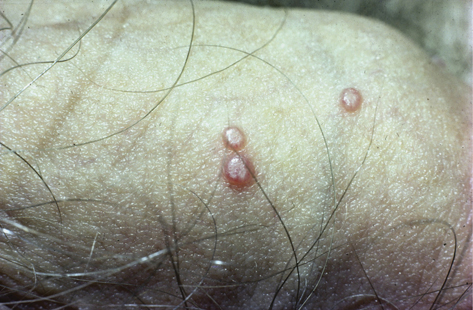
Plate 16 Molluscum contagiosum (24).
First described in 1817. Viral origin discovered by Juliusburg in 1907.
Benign skin eruption caused by replication of the large DNA virus Molluscum contagiosum virus (MCV) in epithelial cells. Family Poxviridae, genus Molluscipox; the 4 subtypes MCV 1–4 are clinically the same. MCV-1 is the commonest, MCV-2 commoner in the immunocompromised, and MCV3 and 4 rare.
Worldwide, more common in warm climates. Equal sex distribution. Transmitted by direct skin-to-skin contact. Microscopic abrasions and a warm moist environment facilitate transmission. Prone to koebnerization. The period of infectivity and viral shedding is thought to be equal to the duration of lesions.
Transmission can be by routine physical contact, commonly seen in:
• pre-adolescent children (90% attending GP are aged <15 years)
• individuals with impaired cellular immunity
• sports involving skin-to-skin contact
• those using gyms, swimming pools, and saunas (including fomites, e.g. shared towels).
If sexually acquired, lesions are often around the anogenital area in:
• sexually active adults aged 20–29 years
• those with a history or presence of other STIs
• those whose partner has molluscum contagiosum.
There are no documented cases of maternal–foetal transmission.
Incubation period usually 2–12 weeks, up to 6 months. Smooth pearly umbilicated lesions (Plate 16), growing over several weeks to a diameter of 2–6 mm, occasionally larger. In adults, when sexually acquired, found in pubic region, thighs, buttocks, lower abdomen, and less commonly, external genitalia sparing mucous membranes. Usually, 1–30 lesions unless immunosuppressed. May appear during pregnancy and generally resolve after delivery. Typically, asymptomatic, but may cause pruritus. 10% develop dermatitis around lesions. Auto-inoculation can occur through excoriation. In children, lesions are characteristic on face, upper limbs, and trunk, but 10–50% have genital lesions.

Plate 16 Molluscum contagiosum (24).
Spontaneous resolution within 2–3 months is common, but recurrences occur in 15–35% over 8–24 months.
Diagnosis is by characteristic appearance of lesions. Atypical lesions may require biopsy. Histology shows enlarged epithelial cells with intra-cytoplasmic molluscum bodies. Molecular diagnostic methods are available, but not used in clinical practice.
Advice regarding auto-inoculation, avoid shaving/waxing, avoid sharing towels. Squeezing can cause superinfection, and viral spread. Cover lesions when swimming, etc. A full STI screen is recommended in those presenting with genital lesions, at least an HIV test in those with facial lesions.
No treatment is advised for immunocompetent patients, as spontaneous resolution with no long-term sequelae is usual. Patients seeking treatment must consider the possible risk of post-treatment scarring. Some treatments may shorten disease course, but data on efficacy is limited. Options include:
• cryotherapy, curettage, electrocautery
• Unnecessary. No evidence that treating partner prevents re-infection.
Molluscum contagiosum is a viral infection spread by skin-to-skin contact. If lesions appear around the genitals has probably been sexually transmitted.
Lesions usually appear after an incubation period of 3–12 weeks, although this can be longer, and usually disappear spontaneously within 2–3 months. Clearance depends on the body mounting a suitable immunological response against the causative poxvirus.
As molluscum resolves spontaneously, treatment is offered for cosmetic purposes only. Generally, people with genital lesions want them cleared up as soon as possible.
The usual treatment is by cryotherapy, but curettage, diathermy, and piercing with an orange stick followed by application of iodine or phenol have also been used. There are limited data on podophyllotoxin cream and imiquimod cream (currently unlicensed).
33% of people will experience recurrences over the next 1–2 years.
Molluscum contagiosum is found in up to 20% of those with HIV. Lesions may become widespread in those with low CD4 counts, and often affect the face. Atypical hypertrophic lesions may be seen. Use of ART may lead to resolution of lesions, but conversely, may present following an immune reconstitution inflammatory syndrome (IRIS) ( Chapter 55, ‘Immune reconstitution’, p. 642). Topical cidofovir or IV cidofovir for extensive recalcitrant molluscum have been tried for non-genital lesions, but no trial data available. Differential diagnosis for umbilicated lesions in immunocompromised patients includes cutaneous cryptococcal infection.
Chapter 55, ‘Immune reconstitution’, p. 642). Topical cidofovir or IV cidofovir for extensive recalcitrant molluscum have been tried for non-genital lesions, but no trial data available. Differential diagnosis for umbilicated lesions in immunocompromised patients includes cutaneous cryptococcal infection.
Further information
British Association for Sexual Health and HIV Molluscum contagiosum guideline  https://www.bashh.org/guidelines
https://www.bashh.org/guidelines